PONTIAC BONNEVILLE 1993 Owners Manual
Manufacturer: PONTIAC, Model Year: 1993, Model line: BONNEVILLE, Model: PONTIAC BONNEVILLE 1993Pages: 322, PDF Size: 16.31 MB
Page 221 of 322
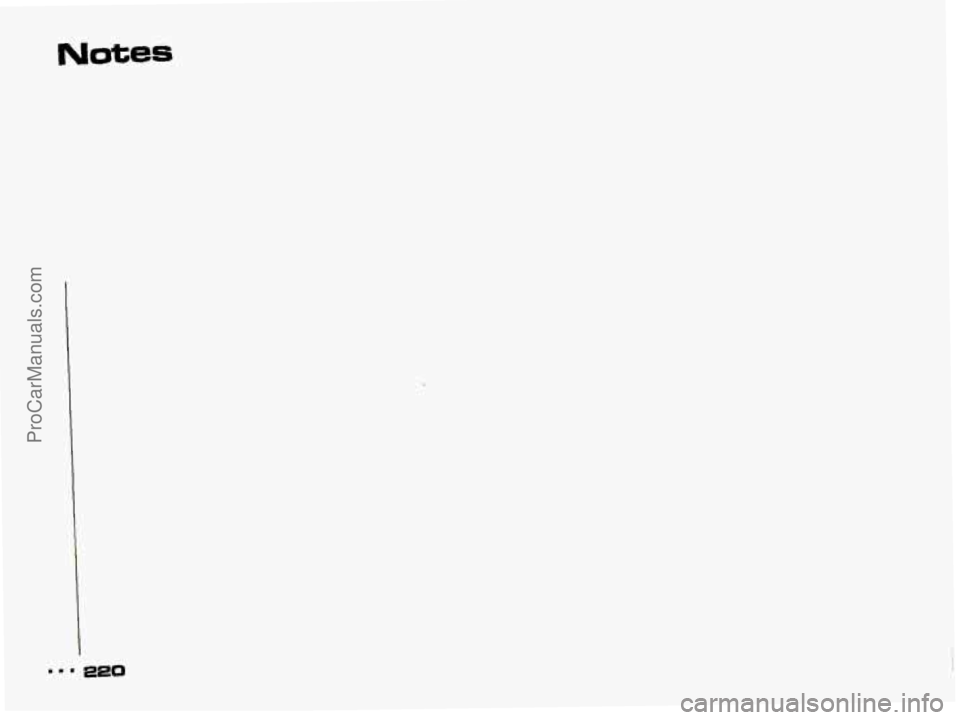
Notes
ProCarManuals.com
Page 222 of 322
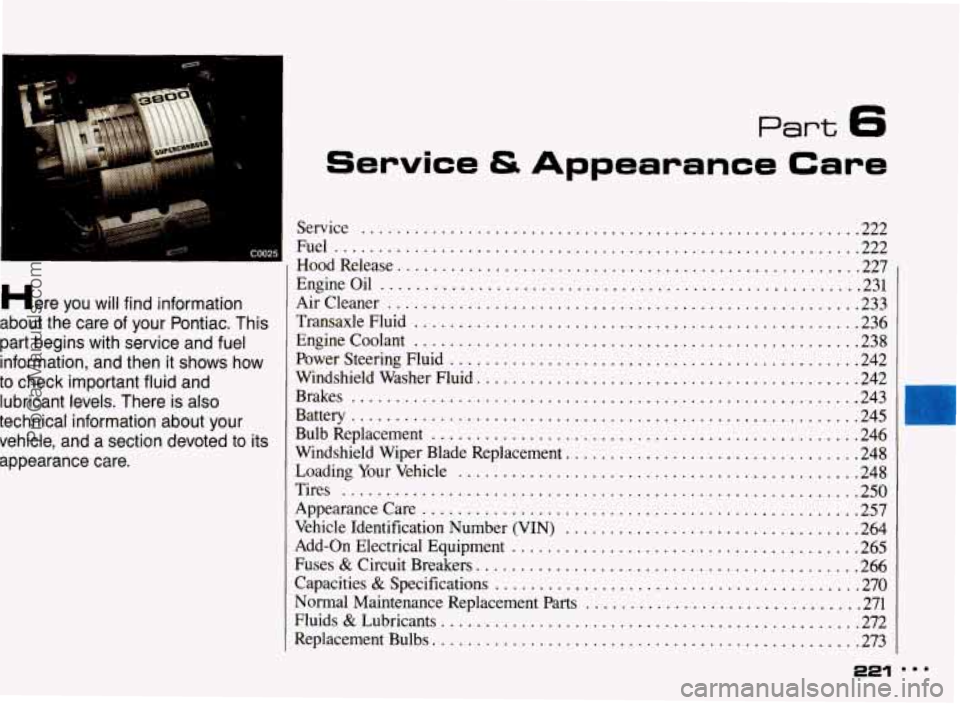
Part 6
I .
COO25
Here you will find information
about the care of your Pontiac
. This
part begins with service and fuel
information. and then it
shows how
to check important fluid and
lubricant levels
. There is also
technical information about your
vehicle. and
a section devoted to its
appearance care
.
Service G Appearance Care
Service ............................. .................. 222
Fuel
......................................................... 222
Engineoil
...................................................... 231
HoodRelease
.................................................... 227
Aircleaner
..................................................... 233
TransaxleFluid
.................................................. 236
Enginecoolant
.................................................. 238
Power Steering Fluid
.............................................. 242
Windshield Washer Fluid
........................................... 242
Bulb Replacement
.............................................. 246
Loading Your Vehicle
............................................. 248
Appearance Care
................................................. 257
Vehicle Identification Number (VIN)
................................. 264
Add-on Electrical Equipment
....................................... 265
Fuses
& Circuit Breakers ........................................... 266
Capacities
& Specifications ......................................... 270
Normal Maintenance Replacement Parts
............................... 271
Fluids
& Lubricants ............................................... 272
Replacement Bulbs
................................................ 273
Brakes
......................................................... 243
Battery
.......................................................... 245
Windshield Wiper Blade Replacement
...................... ....... 248
Tires
.......................................................... 250
221 ...
ProCarManuals.com
Page 223 of 322
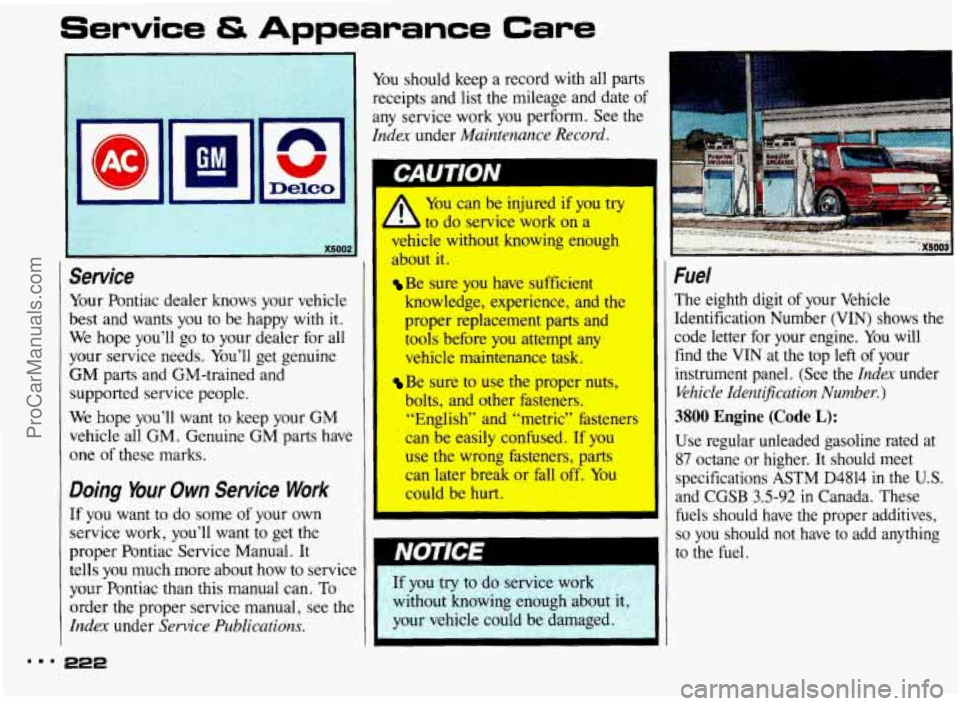
Service & Appearance Care
AC’
Service
Your Pontiac dealer knows your vehicle
best and wants you to be happy with
it.
We hope you’ll go to your dealer for all
your service needs. You’ll get genuine
GM parts and GM-trained and
supported service people.
We hope you’ll want to keep your
GM
vehicle all GM. Genuine GM parts have
one of these marks.
Doing Your Own Service Work
If you want to do some of your own
service work, you’ll want to get the
proper Pontiac Service Manual. It
tells you much more about how to service
your Pontiac than this manual can. To
order the proper service manual, see the
Index under Service Publications.
You should keep a record with all parts
receipts and list the mileage and date
of
any service work you perform. See the
Index under Maintenance Record.
I
I You can be injured if you try
to do service work on a
vehicle without knowing enough
about
it.
Be sure you ha! - uffcient
I
knowledge, experience, and the
proper replacement
parts and
tools before you attempt any
vehicle maintenance task.
Be sure to use the proper nuts,
bolts, and other fasteners.
“English” and “metric” fasteners
can be easily confused. If you
use the wrong Edsteners, parts
can later break or fall off. You
could be hup
r
If you try to do service work
without knowing enough about
it,
your vehicle could be damaged.
Fuel
The eighth digit of your Vehicle
Identification Number (VIN) shows the
code letter for your engine.
You will
find the VIN at the top left
of your
instrument panel. (See the
Index under
&hide Identljication Number-.)
3800 Engine (Code L):
Use regular unleaded gasoline rated at
87 octane or higher. It should meet
specifications
ASTM D4814 in the U.S.
and
CGSB 3.5-92 in Canada. These
fuels should have the proper additives,
so you should not have to add anything
to the fuel.
m.. 222
ProCarManuals.com
Page 224 of 322
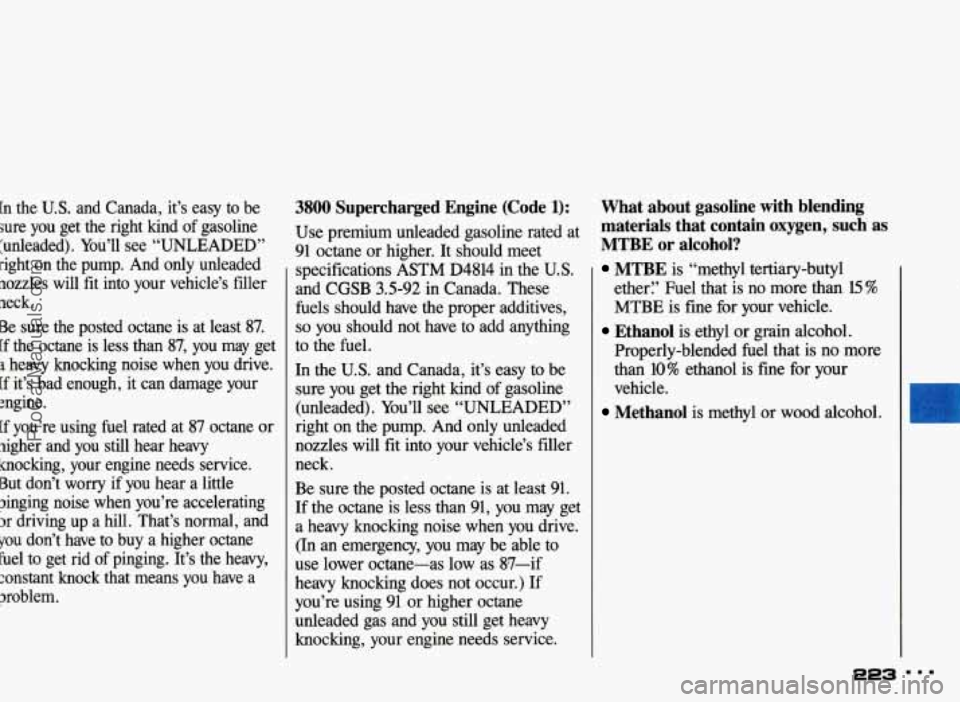
[n the U.S. and Canada, it’s easy to be
sure you get the right kind of gasoline
‘unleaded). You’ll see “UNLEADED”
Pight on the pump. And only unleaded
aozzles will fit into your vehicle’s filler
neck.
Be sure the posted octane is at least
87.
[f the octane is less than 87, you may get
1 heavy knocking noise when you drive.
[fit’s bad enough, it can damage your
:ngine.
[f you’re using fuel rated at 87 octane or
nigher and you still hear heavy
knocking, your engine needs service.
But don’t worry if you hear a little
inging noise when you’re accelerating
3r driving up a hill. That’s normal, and
vou don’t have to buy a higher octane
Fuel to get rid of pinging. It’s the heavy,
:onstant knock that means you have a
xoblem. specifications
ASTM D4814
in the U.S.
and CGSB 3.5-92 in Canada. These
fuels should have the proper additives,
so you should not have to add anything
to the fuel.
In the U.S. and Canada, it’s easy to be
sure you get the right kind of gasoline
(unleaded). You’ll see “UNLEADED”
right on the pump. And only unleaded
nozzles will fit into your vehicle’s filler
neck.
Be sure the posted octane is at least 91.
If the octane is less than 91, you may get
a heavy knocking noise when you drive.
(In an emergency, you may be able to
use lower octane-as low as 87-if
heavy knocking does not occur.) If
you’re using 91 or higher octane
unleaded gas and you still get heavy
knocking, your engine needs service.
MTBE is “methyl tertiary-butyl
ether:’ Fuel that is no more than
15 %
MTBE is fine for your vehicle.
Ethanol is ethyl or grain alcohol.
Properly-blended fuel that is no more
than
10% ethanol is fine for your
vehicle.
Methanol is methyl or wood alcohol.
ProCarManuals.com
Page 225 of 322
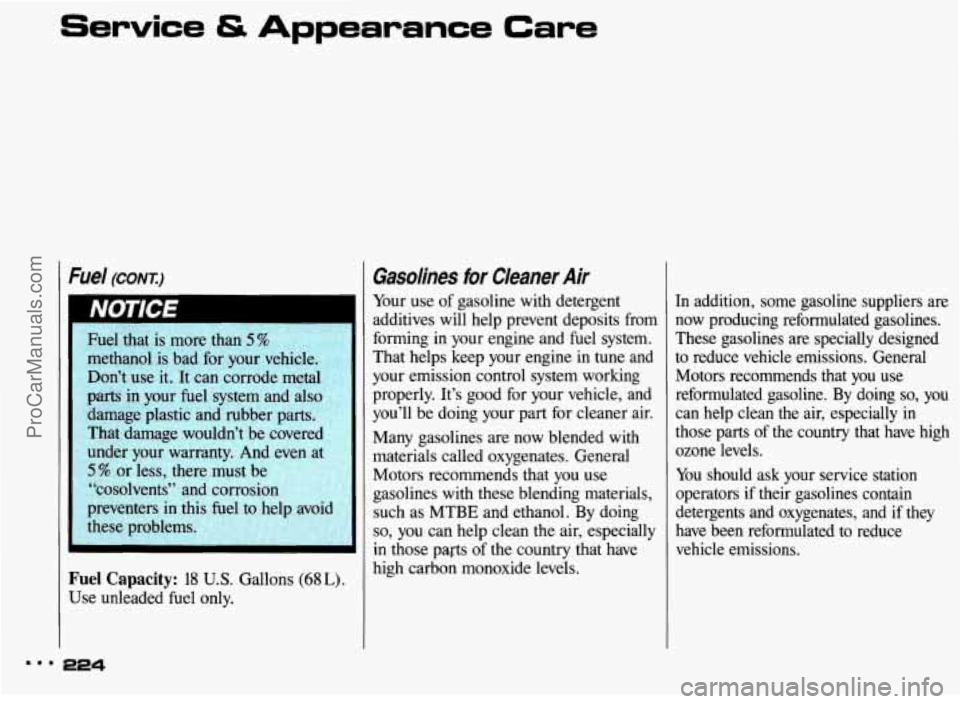
Service & Appearance Care
:#el (CONTI
Fuel that is more than 5 %
methanol is bad for your vehicle.
Don’t use it. It can corrode metal
parts
in your fuel system and also
damage plastic and rubber parts.
That damage wouldn’t be covered
under your warranty. And even at
5% or less, there must be
“cosolvents” and corrosion
preventers
in this fuel to help avoid
these problems.
bel Capacity: 18 U.S. Gallons (68 L).
Ise unleaded fuel only.
Gasolines for Cleaner Air
Your use of gasoline with detergent
additives will help prevent deposits from
forming
in your engine and fuel system.
That helps keep your engine in tune and
your emission control system working
properly. It’s good for your vehicle, and
you’ll be doing your part for cleaner air.
Many gasolines are now blended with
materials called oxygenates. General
Motors recommends that you use
gasolines with these blending materials, such as MTBE and ethanol. By doing
so, you can help clean the air, especially
in those pa@ of the country that have
high carbon monoxide levels. In
addition, some gasoline suppliers are
now producing reformulated gasolines.
These gasolines are specially designed
to reduce vehicle emissions. General
Motors recommends that you use
reformulated gasoline. By doing
so, you
can help clean the air, especially in
those parts of the country that have high
ozone levels.
You should ask your service station
operators
if their gasolines contain
detergents and oxygenates, and if they
have been reformulated to reduce
vehicle emissions.
ProCarManuals.com
Page 226 of 322
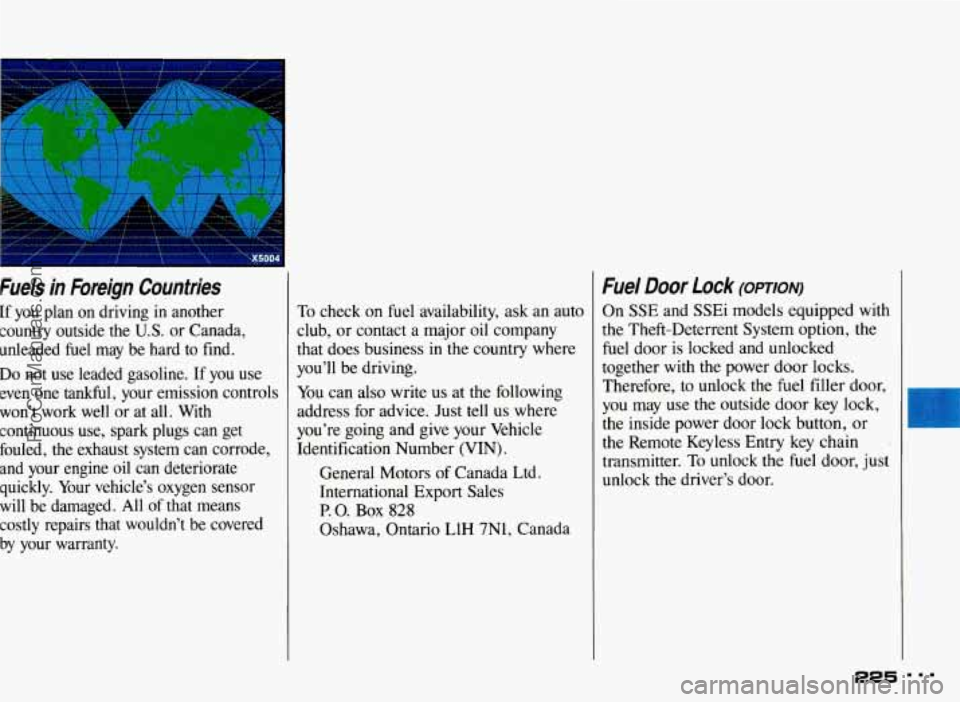
Fuels in Foreign Countries
tf you plan on driving in another
country outside the
U.S. or Canada,
unleaded fuel may be hard to find.
Do not use leaded gasoline. If you use
even one tankful, your emission controls
won’t work well or at all. With
continuous use, spark plugs can get
fouled, the exhaust system can corrode,
and your engine oil can deteriorate
quickly. Your vehicle’s oxygen sensor
will be damaged. All of that means
costly repairs that wouldn’t be covered
by your warranty. To
check on fuel availability, ask an auto
club, or contact a major oil company
that does business in the country where
you’ll be driving.
You can also write us at the following
address for advice. Just tell us where
you’re going and give your Vehicle
Identification Number (VIN).
General Motors
of Canada Ltd.
International
Export Sales
P. 0. Box 828
Oshawa, Ontario L1H 7N1, Canada
Fuel Door Lock (omoN)
On SSE and SSEi models equipped with
the Theft-Deterrent System option,
the
fuel door is locked and unlocked
together with the power door locks.
Therefore, to unlock the fuel filler door,
you may use the outside door key lock,
the inside power door lock button, or
the Remote Keyless Entry key chain
transmitter.
To unlock the fuel door, just
unlock the driver’s door.
225
ProCarManuals.com
Page 227 of 322
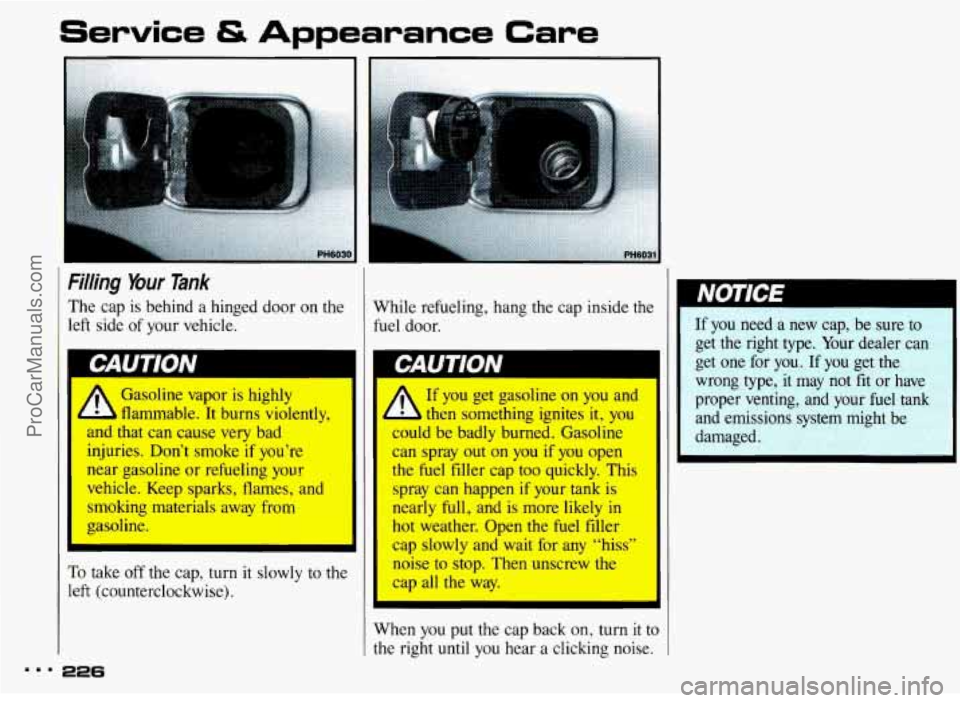
Service & Appearance Care
Filling Your Tank
The cap is behind a hinged door on the
left side of your vehicle.
Gasoline vapor is highly
flammable. It burns violently,
and that can cause very bad
I injuries. Don’t smoke if you’re
ar gasoline or refueling your
vehicle. Keep sparks, flames, and
smoking materials away from
gasoline.
I
To take off the cap, turn it slowly to the
left (counterclockwise), While refueling, hang
the cap inside the
fuel door.
I
A If you get gasoline on you and
L then something ignites it, you
L.udd be badly burned. Gasoline
can spray out on you if you open
the fuel filler cap too quickly. This
spray can happen if your tank is
nearly
full, and is more likely in
hot weather. Open the fuel filler
cap slowly and wait for any “hiss”
noise to stop. Then unscrew the
cap all the way.
When you put the cap back on, turn
it to
the right until you hear a clicking noise.
m.. 226
If you need a new cap, be sure to
get the right type. Your dealer
get one for you. If you get the
wrong type,
it may not fit or have
proper venting, and your fuel tank
and emissions system
might be
damaged.
ProCarManuals.com
Page 228 of 322
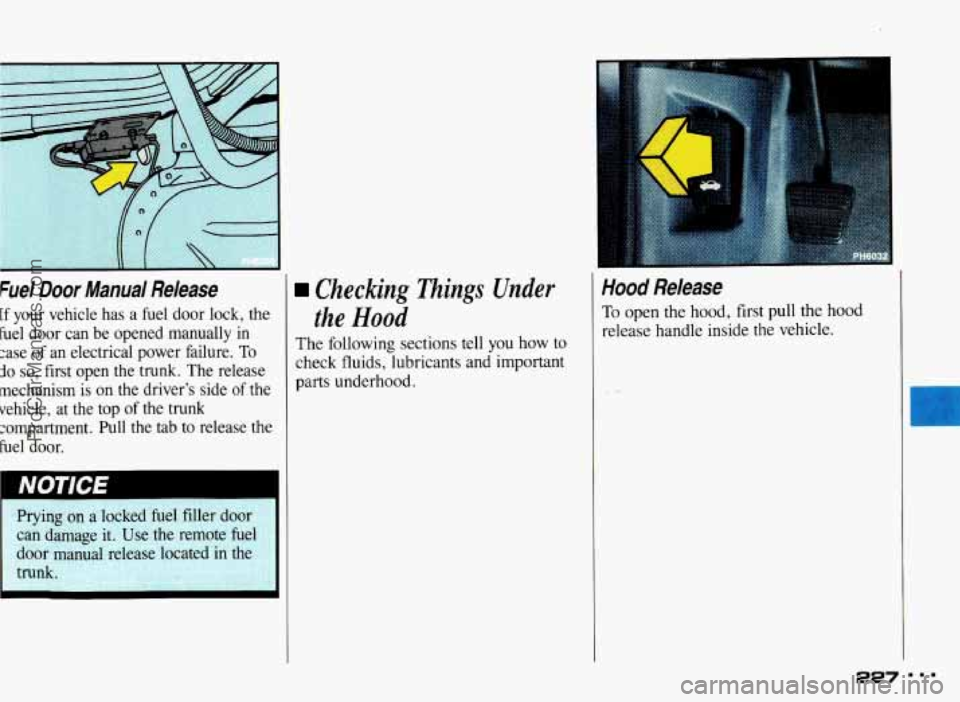
Fuel Door Manual Release
[f your vehicle has a fuel door lock, the
Fuel door can be opened manually
in
;ase of an electrical power failure. To
io so, first open the trunk. The release
mechanism is
on the driver's side of the
vehicle, at the top
of the trunk
2ompartment. Pull the tab to release the
fuel door.
Checking Things Under
the Hood
The following sections tell you how to
check fluids, lubricants and important
parts underhood.
Hood Release
To open the hood, first pull the hood
release handle inside the vehicle.
ProCarManuals.com
Page 229 of 322
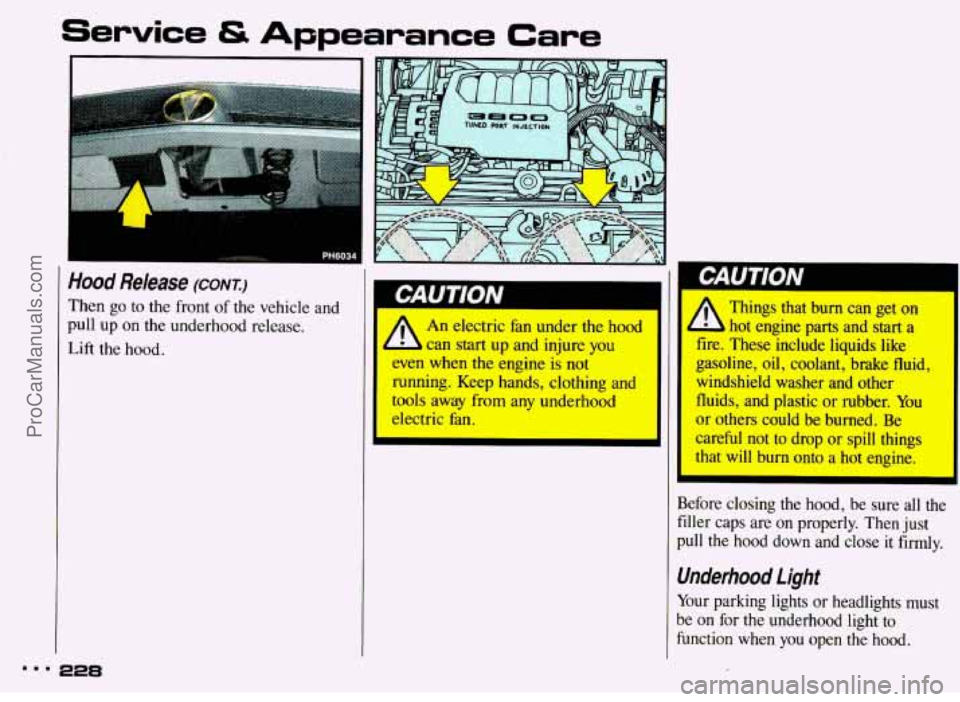
Service & Appearance Care
Hood Release (CONT.)
Then go to the front of the vehicle and
pull up on the underhood release.
Lift the hood.
Dm. 228
I
I GAUTION I I 11
Qr
An electric fim under the hood
can start up and injure you
even when the engine is not
running. Keep hands, clothing and
tools away from any underhood
electric fan.
lefore closing the hood, be sure all the
Her caps are on properly. Then
just
ull the hood down and close it firmly.
hderhood light
bur parking lights or headlights must
le on for the underhood light to
unction when you open the hood.
ProCarManuals.com
Page 230 of 322
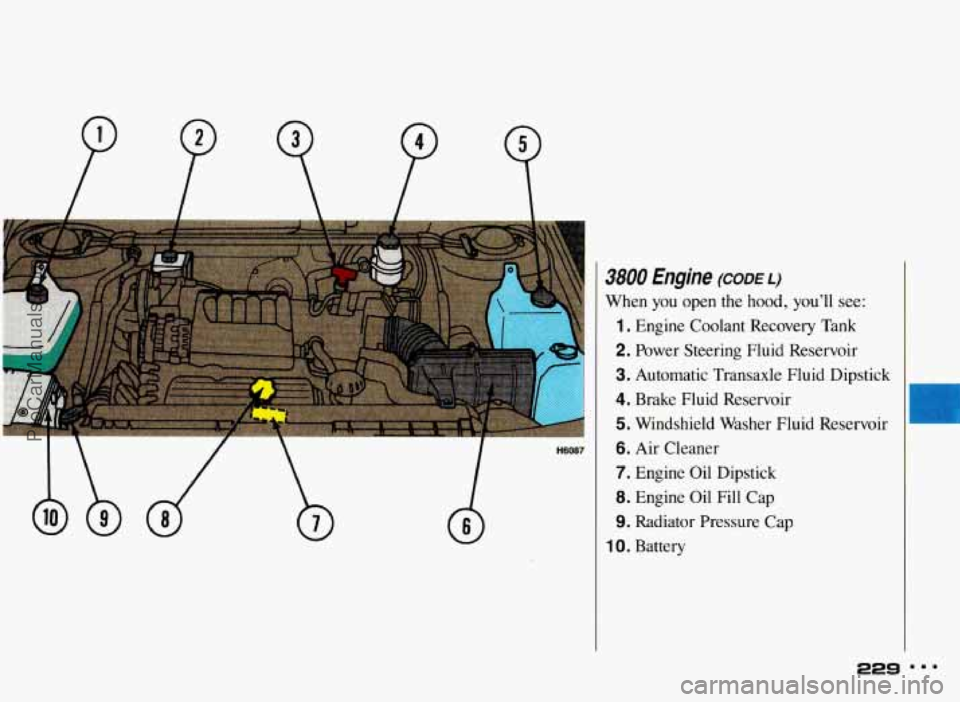
3800 Engine (CODE L)
When you open the hood, you’ll see:
1. Engine Coolant Recovery Tank
2. Power Steering Fluid Reservoir
3. Automatic Transaxle Fluid Dipstick
4. Brake Fluid Reservoir
5. Windshield Washer Fluid Reservoir
6. Air Cleaner
7. Engine Oil Dipstick
8. Engine Oil Fill Cap
9. Radiator Pressure Cap
1 0. Battery
229
ProCarManuals.com